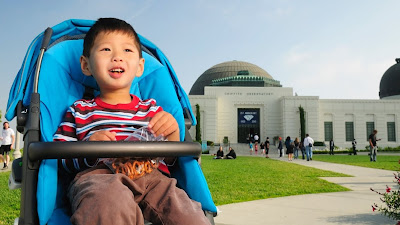
In the shot above, we were visiting the Griffith Observatory and it was quite sunny. Fortunately there was a shaded spot from the monument in front of the observatory. In the shade, it was possible for my little SB-800 with a propet handheld umbrella to act as key light. Steps:
1. Position subject in the shade.
2. With the flash off, set exposure for the sunlit background (or allow slight underexposure if you want to emphasize the subject -- but this will require more power from your flash).
- I used manual exposure for maximum control.
- Metering mode was matrix. This allows the flash to function in i-TTL BL mode (which tries to balance the flash exposure with the ambient exposure)
- I set the ISO to the base ISO of 200 for the D300.
- I set shutter speed to the sync speed 1/250.
- I set aperture so that the light meter was at 0. With a circular polarizer attached (for a bluer sky), aperture was at f/7.1.
- I took a test shot. Background looked ok.
3. I took a shot with the flash, aiming the flash in the same direction as the ambient light.
- I raised the popup flash to get ready to use it as a commander.
- I switched the flash to commander mode using the camera's menus.
- Because the subject is in shadow, the ambient light within the shaded area acts as natural fill, so I set the popup flash to inactive (it will only act as commander - it will not contribute light).
- I set the remote flash on TTL.
- My SB800 was mounted on a propet umbrella as a modifier. I aimed it in the same direction as the ambient light.
- I took a shot. If it looks ok then you're done.
4. Adjust TTL as necessary.
- I felt the flash exposure was too high. I adjusted to -0.7 FEC. This became the final shot. (In post processing, I reduced contrast slightly, cropped slightly, and straightened the picture).
 |
| From Maty 33+ Months |


Mic, I think your article is very informative, but what do you mean in point 2 "I set aperture so that the light meter was at 0. With a circular polarizer attached (for a bluer sky), aperture was at f/7.1." Am I missing something?
ReplyDeleteHi there! In this case I was using manual exposure. What I meant was that I used the base ISO (200 for the D300), then set the shutter to the sync speed (1/250 for the D300). Then for the aperture I set it at whatever setting would be neither overexposed nor underexposed according to the internal light meter, i.e., I used a normal exposure. In this case, that setting was f/7.1. Does that make sense?
DeleteBest regards,
Mic